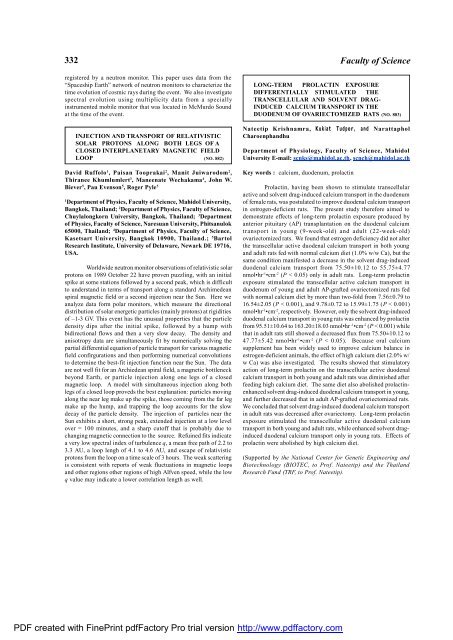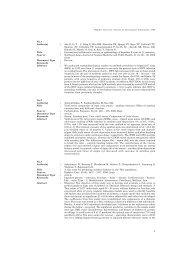Faculty of Science - Mahidol University
Faculty of Science - Mahidol University
Faculty of Science - Mahidol University
You also want an ePaper? Increase the reach of your titles
YUMPU automatically turns print PDFs into web optimized ePapers that Google loves.
332<br />
registered by a neutron monitor. This paper uses data from the<br />
“Spaceship Earth” network <strong>of</strong> neutron monitors to characterize the<br />
time evolution <strong>of</strong> cosmic rays during the event. We also investigate<br />
spectral evolution using multiplicity data from a specially<br />
instrumented mobile monitor that was located in McMurdo Sound<br />
at the time <strong>of</strong> the event.<br />
INJECTION AND TRANSPORT OF RELATIVISTIC<br />
SOLAR PROTONS ALONG BOTH LEGS OF A<br />
CLOSED INTERPLANETARY MAGNETIC FIELD<br />
LOOP (NO. 882)<br />
David Ruffolo 1 , Paisan Tooprakai 2 , Manit Juiwarodom 2 ,<br />
Thiranee Khumlumlert 3 , Maneenate Wechakama 4 , John W.<br />
Biever 5 , Pau Evenson 5 , Roger Pyle 5<br />
1 Department <strong>of</strong> Physics, <strong>Faculty</strong> <strong>of</strong> <strong>Science</strong>, <strong>Mahidol</strong> <strong>University</strong>,<br />
Bangkok, Thailand; 2 Department <strong>of</strong> Physics, <strong>Faculty</strong> <strong>of</strong> <strong>Science</strong>,<br />
Chuylalongkorn <strong>University</strong>, Bangkok, Thailand; 3 Department<br />
<strong>of</strong> Physics, <strong>Faculty</strong> <strong>of</strong> <strong>Science</strong>, Naresuan <strong>University</strong>, Phitsanulok<br />
65000, Thailand; 4 Department <strong>of</strong> Physics, <strong>Faculty</strong> <strong>of</strong> <strong>Science</strong>,<br />
Kasetsart <strong>University</strong>, Bangkok 10900, Thailand.; 5 Bartol<br />
Research Institute, <strong>University</strong> <strong>of</strong> Delaware, Newark DE 19716,<br />
USA.<br />
Worldwide neutron monitor observations <strong>of</strong> relativistic solar<br />
protons on 1989 October 22 have proven puzzling, with an initial<br />
spike at some stations followed by a second peak, which is difficult<br />
to understand in terms <strong>of</strong> transport along a standard Archimedean<br />
spiral magnetic field or a second injection near the Sun. Here we<br />
analyze data form polar monitors, which measure the directional<br />
distribution <strong>of</strong> solar energetic particles (mainly protons) at rigidities<br />
<strong>of</strong> –1-3 GV. This event has the unusual properties that the particle<br />
density dips after the initial spike, followed by a hump with<br />
bidirectional flows and then a very slow decay. The density and<br />
anisotropy data are simultaneously fit by numerically solving the<br />
partial differential equation <strong>of</strong> particle transport for various magnetic<br />
field confirgurations and then performing numerical convolutions<br />
to determine the best-fit injection function near the Sun. The data<br />
are not well fit for an Archiedean spiral field, a magnetic bottleneck<br />
beyond Earth, or particle injection along one legs <strong>of</strong> a closed<br />
magnetic loop. A model with simultaneous injection along both<br />
legs <strong>of</strong> a closed loop proveds the best explanation: particles moving<br />
along the near leg make up the spike, those coming from the far leg<br />
make up the hump, and trapping the loop accounts for the slow<br />
decay <strong>of</strong> the particle density. The injection <strong>of</strong> particles near the<br />
Sun exhibits a short, strong peak, extended injection at a low level<br />
over = 100 minutes, and a sharp cut<strong>of</strong>f that is probably due to<br />
changing magnetic connection to the source. Refuined fits indicate<br />
a very low spectral index <strong>of</strong> turbulence q, a mean free path <strong>of</strong> 2.2 to<br />
3.3 AU, a loop lengh <strong>of</strong> 4.1 to 4.6 AU, and escape <strong>of</strong> relativistic<br />
protons from the loop on a time scale <strong>of</strong> 3 hours. The weak scattering<br />
is consistent with reports <strong>of</strong> weak fluctuations in magnetic loops<br />
and other regions other regions <strong>of</strong> high Alfven speed, while the low<br />
q value may indicate a lower correlation length as well.<br />
LONG-TERM PROLACTIN EXPOSURE<br />
DIFFERENTIALLY STIMULATED THE<br />
TRANSCELLULAR AND SOLVENT DRAG-<br />
INDUCED CALCIUM TRANSPORT IN THE<br />
DUODENUM OF OVARIECTOMIZED RATS (NO. 883)<br />
Nateetip Krishnamra, Kukiat Tudpor, and Narattaphol<br />
Charoenphandhu<br />
Department <strong>of</strong> Physiology, <strong>Faculty</strong> <strong>of</strong> <strong>Science</strong>, <strong>Mahidol</strong><br />
<strong>University</strong> E-mail: scnks@mahidol.ac.th, scnch@mahidol.ac.th<br />
Key words : calcium, duodenum, prolactin<br />
<strong>Faculty</strong> <strong>of</strong> <strong>Science</strong><br />
Prolactin, having been shown to stimulate transcellular<br />
active and solvent drag-induced calcium transport in the duodenum<br />
<strong>of</strong> female rats, was postulated to improve duodenal calcium transport<br />
in estrogen-deficient rats. The present study therefore aimed to<br />
demonstrate effects <strong>of</strong> long-term prolactin exposure produced by<br />
anterior pituitary (AP) transplantation on the duodenal calcium<br />
transport in young (9-week-old) and adult (22-week-old)<br />
ovariectomized rats. We found that estrogen deficiency did not alter<br />
the transcellular active duodenal calcium transport in both young<br />
and adult rats fed with normal calcium diet (1.0% w/w Ca), but the<br />
same condition manifested a decrease in the solvent drag-induced<br />
duodenal calcium transport from 75.50±10.12 to 55.75±4.77<br />
nmol•hr -1 •cm -2 (P < 0.05) only in adult rats. Long-term prolactin<br />
exposure stimulated the transcellular active calcium transport in<br />
duodenum <strong>of</strong> young and adult AP-grafted ovariectomized rats fed<br />
with normal calcium diet by more than two-fold from 7.56±0.79 to<br />
16.54±2.05 (P < 0.001), and 9.78±0.72 to 15.99±1.75 (P < 0.001)<br />
nmol•hr -1 •cm -2 , respectively. However, only the solvent drag-induced<br />
duodenal calcium transport in young rats was enhanced by prolactin<br />
from 95.51±10.64 to 163.20±18.03 nmol•hr -1 •cm -2 (P < 0.001) while<br />
that in adult rats still showed a decreased flux from 75.50±10.12 to<br />
47.77±5.42 nmol•hr -1 •cm -2 (P < 0.05). Because oral calcium<br />
supplement has been widely used to improve calcium balance in<br />
estrogen-deficient animals, the effect <strong>of</strong> high calcium diet (2.0% w/<br />
w Ca) was also investigated. The results showed that stimulatory<br />
action <strong>of</strong> long-term prolactin on the transcellular active duodenal<br />
calcium transport in both young and adult rats was diminished after<br />
feeding high calcium diet. The same diet also abolished prolactinenhanced<br />
solvent drag-induced duodenal calcium transport in young,<br />
and further decreased that in adult AP-grafted ovariectomized rats.<br />
We concluded that solvent drag-induced duodenal calcium transport<br />
in adult rats was decreased after ovariectomy. Long-term prolactin<br />
exposure stimulated the transcellular active duodenal calcium<br />
transport in both young and adult rats, while enhanced solvent draginduced<br />
duodenal calcium transport only in young rats. Effects <strong>of</strong><br />
prolactin were abolished by high calcium diet.<br />
(Supported by the National Center for Genetic Engineering and<br />
Biotechnology (BIOTEC, to Pr<strong>of</strong>. Nateetip) and the Thailand<br />
Research Fund (TRF, to Pr<strong>of</strong>. Nateetip).<br />
PDF created with FinePrint pdfFactory Pro trial version http://www.pdffactory.com
















